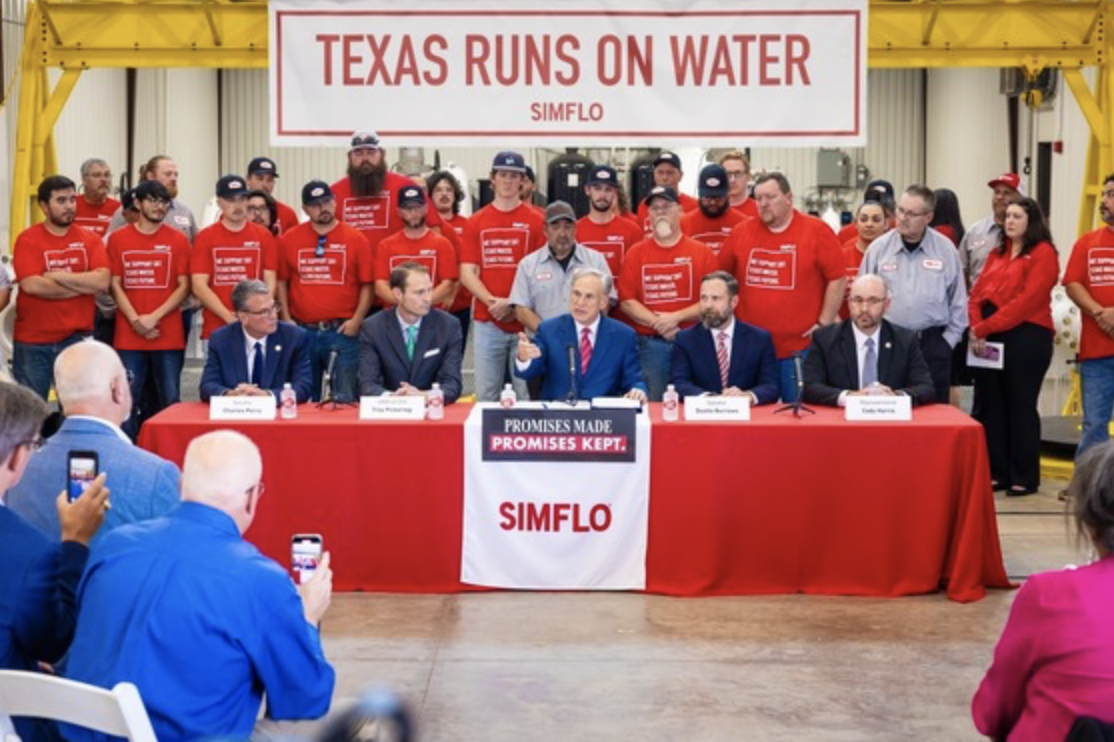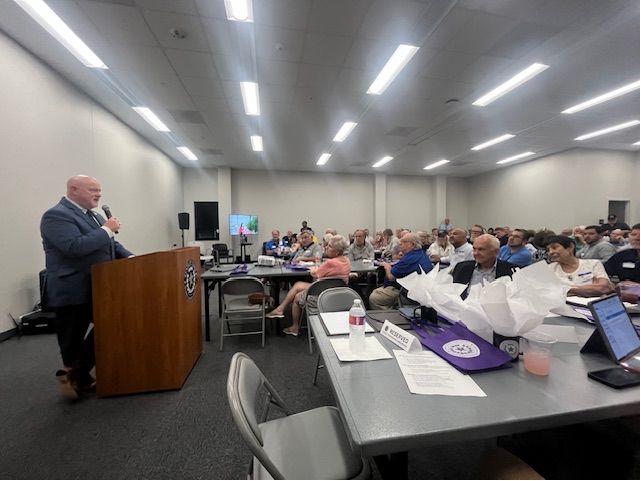
Governor Abbott Signs Historic $20 Billion Water Infrastructure Bill: Texas Water Districts Advocate AWBD Breaks Down What It Means for Houston-Area MUDs and Homeowners
In a bold move to “secure Texas’ water future,” Governor Greg Abbott has signed into law Senate Bill 7 and House Joint Resolution 7—ushering in the largest water infrastructure investment in Texas history. The $20 billion plan spans two decades, directing $1 billion annually toward repairing aging systems and expanding water supply across the state.
“This law…provides a $20 billion generational investment for both new water supply and for the repairing of existing infrastructure,” said Governor Abbott during a ceremonial signing in Lubbock. “With this law, we will secure Texas’ water future for generations to come.”
But what does this mean for local communities, particularly the thousands of suburban neighborhoods in the Houston region served by Municipal Utility Districts (MUDs)? For Rick Ellis, Executive Director of the Association of Water Board Directors (AWBD), the news was both gratifying and surprising.
“Relief, thankfulness, and a little surprise!” Ellis said when asked for his reaction. “Surprise because advocates were hoping to get $1 billion a year for 10 years…getting $1 billion each year for 20 years is a bonus!”
A Lifeline for Water Infrastructure in Houston and Beyond
Texas is growing fast—adding more than 1,500 new residents each day. Nowhere is this growth more visible than in Houston’s rapidly expanding suburban areas. More than 750 MUDs represented by AWBD operate across the state, many of them concentrated in Greater Houston, managing everything from water treatment and distribution to sewer services and drainage.
For these districts, Senate Bill 7 and the Texas Water Fund created by House Joint Resolution 7 are nothing short of a game-changer. According to Ellis, the new funding “will lead to improved water supply reliability and the ability to meet the growing water demands of the state. More money = more projects.”
Mobile Sidebar Ad
This means much-needed upgrades for aging pipes, wastewater treatment facilities, and stormwater systems, many of which were built decades ago and are now showing signs of wear.
“SB7 broadens the types of water projects that can be funded, including water reuse, wastewater, flood control, and agricultural water conservation,” Ellis explained. “HJR7 will provide MUDs with a stable source of financial support to address critical water infrastructure needs.”
Addressing the Unique Challenges of MUDs
Unlike city utilities, MUDs must finance their services independently—often resulting in higher taxes or fees for residents. That financial burden has historically made it difficult for some districts to keep pace with infrastructure maintenance or implement environmentally responsible water practices.
“Repairs and progressive maintenance can be extremely costly,” Ellis noted. “MUDs need to provide essential services… but this can result in higher taxes and fees for residents compared to municipalities.”
The new legislation could significantly alleviate these challenges, especially for older districts facing increased service disruptions or growing pressure from local development. Moreover, the funding mechanisms built into HJR7—including a dedicated portion of the state’s sales and use taxes—promise long-term reliability and budget predictability for utility districts statewide.
 AWBD Executive Director Rick Ellis speaks to a packed room of MUD directors and consultants during
AWBD Executive Director Rick Ellis speaks to a packed room of MUD directors and consultants during A Catalyst for Innovation and Smarter Water Use
Beyond pipe repairs and system upgrades, the funding is expected to accelerate the adoption of smart water technologies and modern conservation strategies. From leak detection systems to advanced irrigation controls, Texas water districts now have the resources to explore more sustainable solutions.
“Water district operators are always searching for new methodologies to keep the water flowing – both ways,” Ellis said. “During the conferences we offer to our membership, we showcase the latest and greatest technologies… to help them make the educated decisions needed to run a district.”
An increasingly urgent challenge in Texas water management is land subsidence, the gradual sinking of land caused by excessive groundwater pumping. In areas like north Harris County, land has sunk by as much as 13 feet, prompting action from several groundwater conservation districts. While Texas law does not require statewide groundwater reduction, multiple districts—including the Harris-Galveston Subsidence District, Lone Star GCD, Fort Bend Subsidence District, and others—have adopted rules that limit groundwater use and promote a transition to surface water.
In Harris County, for example, some areas must reduce groundwater use to 20% or less by 2035. These localized efforts are increasingly common and are helping drive investment in surface water infrastructure—goals strongly supported by the new Texas Water Fund.
And with state-mandated reporting tools now in development through the Texas Water Development Board, districts will also be held to higher standards of transparency and performance accountability.
Ensuring Equity and Local Engagement
As funding rolls out, Ellis emphasized the need for equitable distribution between urban, suburban, and rural districts. While the Texas Water Development Board will oversee fund allocation, AWBD will continue to advocate for districts of all sizes to receive their fair share.
“Large or small, all water districts should be given the opportunity to state their case and request the funding they need,” he said.
AWBD is also working to increase public awareness about the critical role MUDs play in Texans’ daily lives. Often operating quietly in the background, these districts only come into public focus when something goes wrong. But with the spotlight now on water infrastructure, Ellis hopes that residents will take a more active role in understanding and supporting their local water governance.
“MUDs are kind of a well-kept secret—until something goes wrong,” Ellis said. “We hope and anticipate that knowledge and awareness are being passed on to the residents.”
Mobile Sidebar Ad
Looking Ahead: Education, Advocacy, and Action
AWBD, formed in 1975, continues to serve as the state’s largest advocacy organization for water districts. With more than 1,000 member districts, its mission remains focused on education, unification, and advocacy—a mission that’s never been more relevant than now.
“‘Securing Texas' water future’ means taking proactive measures to ensure that Texas has enough water to meet the needs of its growing population, thriving economy, and natural environment,” Ellis emphasized. “AWBD can supplant those efforts by doing exactly what our Mission Statement says – Educate, Unify, and Advocate.”
While Senate Bill 7 is now law, a key next step lies with Texas voters. On November 4, 2025, a constitutional amendment tied to House Joint Resolution 7 will appear on the statewide ballot. If approved, it will secure the long-term funding mechanism for the Texas Water Fund and ensure its full implementation.
As Houston-area MUDs begin planning for the future, this historic investment provides both the means and the momentum to build stronger, smarter, and more sustainable communities for generations to come.
 Tiffany Krenek has been on the My Neighborhood News team since August 2021. She is passionate about curating and sharing content that enriches the lives of our readers in a personal, meaningful way. A loving mother and wife, Tiffany and her family live in the West Houston/Cypress region.
Tiffany Krenek has been on the My Neighborhood News team since August 2021. She is passionate about curating and sharing content that enriches the lives of our readers in a personal, meaningful way. A loving mother and wife, Tiffany and her family live in the West Houston/Cypress region.





